Oregon Shakespeare Festival (OSF) is a high-tech company that produces stage plays complete with custom-fabricated film-quality sets and props designed, built and “wrangled” by top-notch in-house crews.
NOTE: The following is primarily transcribed narrative from OSF Representatives Stuart Cotts; and Jennifer Hanson, Automation Programmer, captured during recent visits with each of them. Some minor changes—a word or phrase here and there—were made to translate conversational to narrative format, or to clarify a concept. Enjoy!
The OSF Campus
Three theaters make up the OSF Campus, positioned along Pioneer Street above East Main Street: the Angus Bowmer Theater (600 seats), named after OSF’s founder Angus L. Bowmer; the Thomas Theater (300 seats), named after OSF Development Director Peter D. Thomas; and the Allen Elizabethan (1200 seats), named in honor of The Paul G. Allen Family Foundation, following a three million dollar grant from the foundation.
The Prestige
The Oregon Shakespeare Festival is the largest regional theater in the United States. Their annual season runs from the end of February to the end of October. They produce their own variations of well-known plays (5-6 Shakespeare; the rest classics) and have recently begun to produce new works that present more contemporary stories. One of OSF’s productions, All The Way, directed by Bill Rauch, traveled to Broadway—and won a Tony Award.
What does it take to earn this kind of prestige? Time, energy and a stellar cast of people from all over the country who work together to bring fantasy to life on stage.
A Peek At Backstage Technology
Patrons of live theater tend to focus on the fantasy presented on stage, and not pay attention to the art—and technology—behind the scenes. Who would have thought theater operations could be computerized? Stuart Cotts.
Lighting Is Everything
Stuart’s background is in stage lighting; he ran the department for 20 years, from 1981-2001. During that time, he oversaw a gradual transition from traditional, basic lighting and simple, manually-controlled spotlights to flashy computerized concert lighting, eventually moving to today’s dramatic large-screen projection shows capable of incorporating realtime images into blends and spreads that become panoramic videos projected during the show.
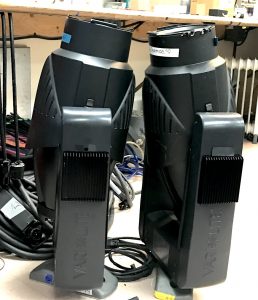
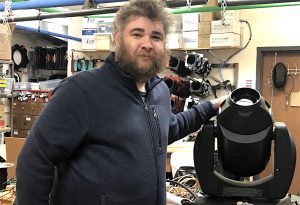
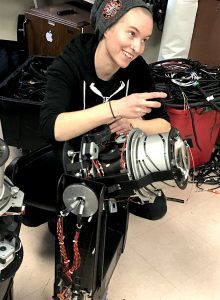
Computerizing Automation
Over the decades, and with the evolution from simple electric lighting to more advanced, electronic-controlled lighting, Stuart gradually taught himself how to program computers.
The process started with the scenery that must be moved on stage. Formerly, hydraulics were used to move objects on stage, via a hand-controlled valve; that method wasn’t very consistent in terms of velocity. Around the turn of this century, the stage automation department moved to DC Servo Technology; the kind of [CNC] technology that’s incorporated into robotic arms and robotics manufacturing, where you achieve very precise movement along an axis. This technology provides discrete control of acceleration and deceleration: 10,000-14,000 steps per inch for moving something on stage. Stuart wrote software (a C# app) that manages this technology to move objects.
Stuart Pivots
Eventually, Stuart merged his organically-developed blend of skills with those of a retired techie friend (who happened to have experience with a major developer of logistics & robotic systems), and they parlayed their combined talents into an informal partnership to produce an intricate system of integrated modules that tracks—and coordinates—the logistics of props, heavy equipment, computerized lighting equipment, scenery, ticketing, players, housing, showtimes, casting, travel, costumes, and costume rentals.
Original Stage Productions
Stepping outside of the actual theater operations, there is the production side of things; OSF productions are performed around the country. Co-producing a play is a popular and cost effective way to share production costs: two theaters may combine their resources to produce a play and then perform that play at both sites. There might be nine productions running at one time, at various sites around the country. The casts travel with the plays, adding to the challenge of personnel logistics: scheduling performances, rehearsals, understudy times, housing and travel for actors.
Different plays have different types of casts. For example, a new production of an old play might require a cast change to reflect the updated version. Sometimes, one actor might play dual roles in the same play. Stu described OSF as being “like a touring company that doesn’t go anywhere.”
Logistics
When it comes to personnel management, OSF coordinates the actors’ multiple roles in multiple plays—including rehearsal times—so the scheduling of actors, plays and showtimes do not conflict, staying true to the protocols that dictate when and how much time an actor is able to devote to a specific task.
The Migration
Beginning in January each year, 40-50 actors arrive in Ashland to begin rehearsals for the current season’s offerings at OSF. An actor might have two or three roles in different plays—some primary, some understudy—depending on how their individual skill set meshes with the requirements of each production. As the season progresses, more actors arrive to fill more roles in more plays, and this continues through the end of October.
The Technology
Technology—both office and operational applications—is at the heart of most businesses these days, and Oregon Shakespeare Festival continues to lead the way in the live theater arena.
OSF uses the popular Tessitura Software for their CRM, ticketing, fundraising and marketing activities. They use Tessitura to build a season, and continue to integrate other software modules as they are able. Their current goal is to integrate calendaring with the other packages.
OSF: A Destination Theater
OSF is a destination theater. Visitors come to Ashland for a weekend—or even a week—and may see up to ten plays during their stay. Considering that there are three stages within the OSF Campus, each of which presents up to two plays per day, the logistics of backstage activities is complex.
Operations Behind The Scenes
While guests mill around the front of the house and comment on the great play they just viewed, dozens of stage crew members are at work backstage—and below stage—breaking down the custom-built sets so the component parts can be efficiently moved and stored in the limited space until the next time they are needed.
Real-Time Process Control
The operations staff (about 30 people) and wardrobe dressers (about 15 people) move like a well-oiled machine to meet schedule demands and last-minute wardrobe changes with the end goal of producing the magic you see on stage: the perfect performance.
Recalling my work with real-time process control in the infancy of my computer career, I was intrigued with what—and how—automation could be computerized, so Stuart arranged for me to meet with Jennifer Hanson, Automation Programmer.
Jennifer greeted me at the Thomas Theater, and led me on a tour of the theater campus underground. Jennifer writes real-time process control computer programs that automate the movement of sets and props, and she explained how these massive sets are monitored and controlled beneath the ground-level stages.
Thomas Theater
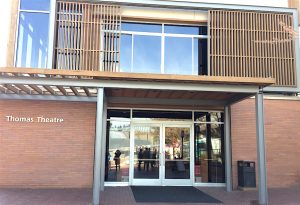

We started below the Thomas Stage, in the Trap Room, where everything beneath the stage happens. In the current play, Hannah and the Dread Gazebo, they raise and lower a 3,000-pound wall by employing 8,000-pounds of counterweights to help control the rise from below deck to deck level, while monitoring the action from computer stations which display camera feeds from stage level.
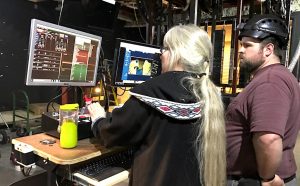
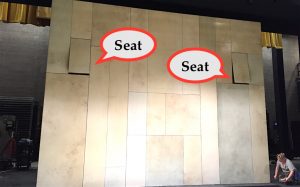
This gigantic wall is operated by two motors; the yellow cable is attached to one motor and there’s another motor and cable on the opposite side. A huge gear controls the operation of the cables.
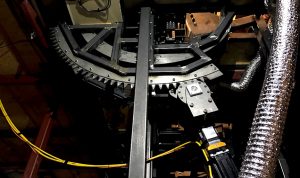
In addition to the gear, there is a 4-tower lift that goes up and down, from stage floor level to beneath the stage.
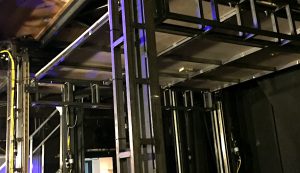
We moved upstairs (to stage level) to see what happens on stage.
The Scene Dock
We arrived at the Scene Dock (like a boat dock…), where the sets are stored.
Because OSF does repertory theater, they swap out the sets. In the morning, they might put up one set and then swap out that set for a different play performed in the evening in the exact same theater.
The Stage Operations Crew (30-40 people; “professional 3D integrators”) disassembles the set, puts the components on an elevator, wheels the set down to the Scene Dock, places the set inside the Dock, gets the next set and puts that set in place.
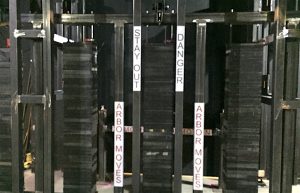
Then we went up top and saw the Wall that gets lowered to beneath the stage.
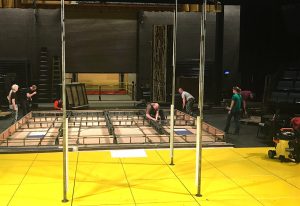


The People Behind The Set
Who is in charge of requesting sets like a gigantic wall?
Bill Rauch, the Artistic Director, selects the play; he picks the director and the set designers for the plays. The Set Designer creates the specifications for the sets and props. So, whoever Bill selects as the Set Designer is the person who dictates what they want the set to look like.
Bill Tiesi, Technical Director of Scenery Department, guides the fabrication of the sets.
James Dean, Automation Supervisor, manages the automation workers: programmers and engineers who automate the operation of the scenery and props.
The Thomas Theater is very versatile, being a theater in the round; thus the seating can be reconfigured to meet the demands of a particular play. The seats are on rails so they can be easily moved on casters.

Controlling Set Movement
Jennifer showed me a piece of scenery that weighs over 250 pounds, and is too heavy for the stage crew to push out on stage, so this large set sits upon wheels (lift casters). To move the scenery, the Stage Crew pushes a button, the button makes the casters pop-up beneath the scenery (raising the platform upon which the scenery is sitting), then the stage crew wheels out the scenery, pushes the button again and the casters disappear back up inside the scenery, and the scenery is then secure enough for the actors to jump and run and hit the table. The casters go up and down about an inch; just enough to move the scenery. They employ two of these lift casters in the current play; each table has four casters.
Angus Bowmer Theater
We moved on to the Angus Bowmer Theater; theater in the round.
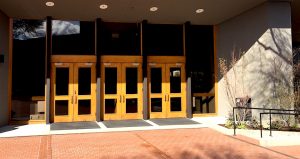
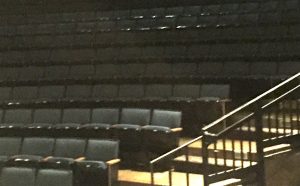
Jennifer immediately pointed out the Scene Dock, where scenery was stored for two plays that were being performed in one theater. Julius Caesar and Mojada sets were in the Dock on this day. Each component of the sets was identified with a numeric marking so stage crews know which “puzzle piece” goes where. Even though the Scene Dock was packed with props, Jennifer noted that this was “nothing, compared to the number of elements stored there during times when there are four plays being performed in the same theater.”
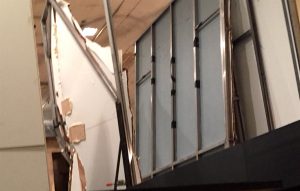
OSF presents up to four plays—with only three stages. Each play may have several performances over a period of a week. And there may be two plays being performed in one theater on any given day. Up to five plays in a day. That would be two in the Thomas, two in the Bowmer and one in the Elizabethan.
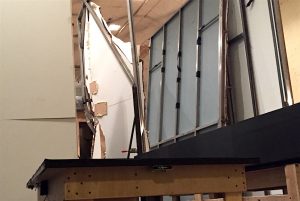
Jennifer showed me some scenery that appeared to be broken but was actually a wall that was purposely-designed to shatter and fall outwards during each performance. The wall shards were actually supported on the back side so the wall could be restored (like reassembling a giant puzzle) and then re-used for the next performance.
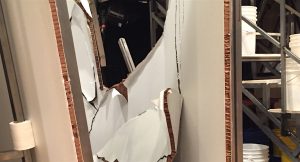
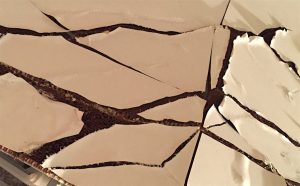
Mojada has a two-story house on set, so they have a whole house [façade, actually] complete with a second-story deck that was positioned behind the stage.
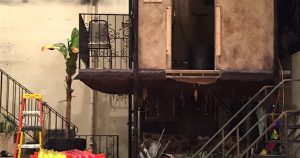
The house for Mojada is moved to the stage through a very tall door that opens to the stage, and the house slides through the opening to the stage.
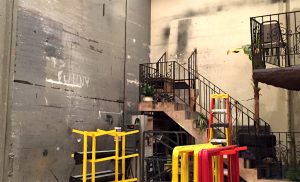
Elizabethan Theater
Moving on to the outdoor Elizabethan Theater…
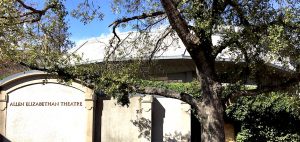
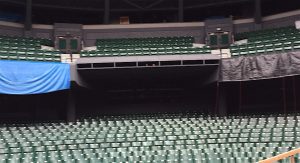
As we proceeded through the various underground walkways between theaters, the path began to feel like a maze. When I mentioned that, Jennifer confided that one of the hazing tricks they play on new employees is to position them in the Bowmer and let them figure out how to get out of the theater.
Moving The Props
The Elizabethan Stage has a big trap door for moving props and actors up and down from beneath the stage; called a Lift.

Then there’s the Slip Stage that is used to slide props and furniture out from behind stage, along a track. There’s also a “piggy” which is a separate piece of equipment that piggybacks on top of the Slip Stage. So they can add wheels to props, connect them to the piggy, and piggyback them along the stage. The Stage Crew regularly employs automation to move the enormous sets and props.
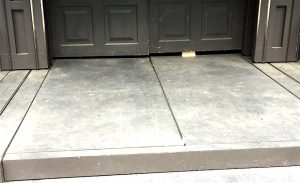
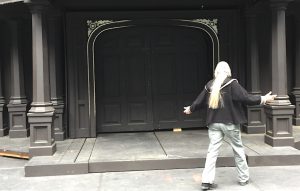
SIDE NOTE: An upcoming production will require a pig to fly; the Automation Department is working on that.
We worked our way back to the Thomas Theater Lobby, where our tour had started (Jennifer thankfully led the way through the “maze”…) and chatted a bit about her experience working at OSF.
About Jennifer
Jennifer began her 12-season career at OSF in the I.T. Department after earning two degrees from SOSC (now SOU): a Bachelor’s in Computer Information Systems and a Master’s in Computer Science & Mathematics, with an interdisciplinary in Education. She began as a Hardware Technician, doing a wide variety of tasks, including installing hardware and doing some programming.
I asked her what drew her to OSF; what was the magnet? She told me about initially working at Darex Corporation until the company merged and laid her off. There happened to be a part-time opening—two openings, actually—at OSF, so Jennifer and her girlfriend, June, both got part-time jobs; they became really good buddies.
The two ladies were at OSF for about 4.5 seasons before the 2008 OSF layoff, when a third of their department was laid off. The I.T. Department lost about four people during that layoff.
When Jennifer left OSF, she taught a bit at SOU and also worked at TreeStar (now FlowJo) in Quality Assurance for about a year-and-a-half. Then her current job became available.
She explained that, when she was originally in the I.T. Department, the job she now holds was the job that everyone wanted. Every computer geek she knows wants her current job. “Because…well, programming is really fun, really cool, you see things you created work…that’s really great. But when you see something you’ve done that makes things move on stage, that’s wa-a-ay cool! It makes the coolness factor so much better than seeing something in 2D on a monitor screen!”
Where The Geeks Are
Everyone in her department are geeks, and when something works, they all rejoice. Her title is Automation Programmer but she does a lot more than simply programming: she hooks up the motors; she hooks up the sensors; she wires everything together. Jennifer also trains Stage Ops on the use of the automation equipment and software. She also will be in “tech”, where they spend days fine-tuning every aspect of the play, from sound, light to automation and acting.
Sensors
What are you sensing? “We sense stuff like the end of travel for the machine; we don’t want a piece of scenery or a prop to travel beyond a certain point, so we will place a sensor at both ends of the machine and then another one somewhere in the middle that indicates if you come to this point, this is a good number at this position, so the trackers can calibrate their stops; this process is called homing.”
“Also, on occasion, we will add sensors for safety. For example, in All The Way, we had a desk that was the lift—and was also the stage floor. So people would walk on the top of the desk (when the desk was below the surface, the desktop level with the stage floor), but then the desk would lift up and become a desk sitting on top of the stage floor. The desk has drawers. So you can imagine: if someone opens a drawer, and the desk goes down, the lift wins and the drawer (and other components) can get crushed—which has the negative effect of upsetting the Props Department (because the desk is a prop that just got crushed)—so we place a sensor on the drawer. Jennifer programs the software to not move the desk/lift if there’s a sensor tripped, and the lift operator actually has the ability to override the automated process of the lift.”
Moving The Scenery
Will the Wall and other set components be transferred to the OSF Warehouse in Talent? “No. What really sets OSF apart from other theaters, is that we rep(ertory) our automation. So, that huge wall you saw in the Thomas Theater is going to go away; the Stage Ops Crew will come in and take the Wall down and stow the Wall in the back. And then, when the time comes for that play to happen again, the Stage Ops Crew will come in again and set up the Wall again. And the crew does all that within a couple of hours—between plays.”
“The sets only go to the OSF Warehouse (located in Talent) if they need work; else they are stored onsite on the OSF Campus. The sets are built in Talent and, thereafter, remain in the theater. If a set needs to be reworked, and that work can be done inside the theater, they will do the work there; else, the set is transported to Talent via pickup truck; Talent is where we fabricate the custom sets.”
Recycling
“At the end of the season, all the sets are discarded. Actually, lately, they’ve been donating the components to Restore in Medford. They used to pay for up to three dumpsters and call for dumpster pickup 3-4 times a week—and pay for the dumpsters. Now they donate the sets to Restore.”
The Passion
What do you love about working at OSF? “The people. This is the best place to work! When I worked at Darex, they always got the award for the 100 best places to work in Oregon, and I thought, ‘there’s no place better to work’—until I started working at OSF.”
What do you love about the people? “It’s a big family.”
I suspect that everybody is judged on their merit. “Yes! People here expect quality.”
When everybody’s producing quality, everybody else is inspired to produce quality. “True!”
Thanks!
I thanked her for the tour as we shook hands, and then she went off to consider how to make pigs fly.
Author: Karen
Vetted By: Jennifer Hanson & Stuart Cotts
Additional Photographs By: Mercedes B. Ly
Written: 4/4/17
Published: 4/5/17
Copyright © 2017, FPP, LLC. All rights reserved.